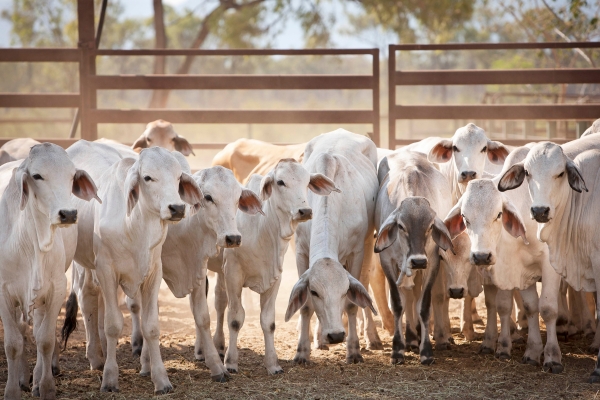Buffalo fly (Haematobia irritans exigua) is the most economically significant parasite to the Australian cattle industry, costing the industry more than $170M per year in lost production, prevention, and treatment costs.1

These small, blood-sucking flies bite host cattle up to 40 times per day, mainly attacking the withers, shoulders, flanks, and around the eyes.
Heavy infestations can cause intense irritation and discomfort for cattle and can result in skin ulcers and reduced hide value.
The severe irritation disrupts grazing and thereby reduces feed intake, growth rates, and milk production.
Even moderate pressure can reduce weight gain by 15 kg2 over the season or milk production by more than 0.5 L per day.3
Buffalo flies can also be a vector for bacteria that cause diseases such as pinkeye.
Buffalo flies are found throughout tropical, sub-tropical, and some temperate regions of northern Australia. This can extend as far south as the mid-north coast of New South Wales, with the intensity and duration of fly pressure reported to be increasing in endemic areas.1
Buffalo flies can infest cattle of all ages, with bulls, cattle with dark coats, or those in poor condition more susceptible. Some animals are more sensitive to flies and can be irritated by as few as four or five flies.
Females leave their host animal briefly to lay their eggs in fresh dung pats before returning to a host animal.
The life cycle is temperature dependent with warm, wet weather conditions between 25 and 35 degrees favouring egg development.
Under ideal conditions, the life cycle can be completed as quickly as 12 to 14 days, allowing the size of the populations to increase rapidly.
Elanco Brand Manager, Kim Krilich, said while selective breeding and non-chemical control methods can help to reduce fly burdens, the strategic and sustained application of chemical treatments remains the most effective way to manage buffalo flies.
“The goal is to manage the fly population at a level that doesn’t result in production setbacks,” she said.
“Applying a knockdown treatment such as Baymec™ Pour-On early in the fly season – say October or November – will help to suppress the emerging fly population.
“Monitor fly pressure and then apply an insecticidal ear tag to provide residual control during the peak season when fly pressure is greatest.
“Elanco’s insecticidal ear tags provide up to four months’ protection against buffalo flies, are easy to apply, and have no withholding periods.
“A second knockdown treatment may be required at the end of the season in March or April, which can minimise overwintering of the fly population.”
The three main chemical families used to control buffalo flies in cattle are organophosphates (OPs), synthetic pyrethroids (SP), and macrocyclic lactone (MLs).
“Only apply modes of action that are known to be effective in your region,” Kim said.
“It is important to rotate between different chemical modes of action within each season and from year to year to prolong the life of all available chemistry.
“Likewise, it is very important that all insecticidal ear tags are removed at the end of their payout period to ensure flies are not exposed to sub-lethal concentrations.
“It is a good idea to maintain a record of all chemical treatments applied each year to assist with your rotation program.
“Given buffalo flies can spread across properties, it’s recommended to coordinate your rotation program with neighbours to provide better control of populations.”
Co-Ral™ Plus, Cylence™ Ultra and Patriot™ insecticidal ear tags from Elanco are ideal for use in rotation programs with ML ear tags to help mitigate the development of resistance.
Co-Ral Plus is a unique combination of two OP active ingredients (200 g/kg diazinon and 200 g/kg coumaphos) in a two-tag system.
Cylence Ultra contains new-generation SP chemistry (80 g/kg betacyfluthrin and 200 g/kg piperonyl butoxide), also in a two-tag system.
Patriot contains OP chemistry (400 g/kg diazinon) in the convenience of a single ear tag.
For further information on buffalo fly management, visit farmanimal.elanco.com/au or contact your local Elanco representative.
This article was written by Elanco for Seasons magazine.
Please note: this article contains information of a general nature, and does not take into account your personal objectives, situation or needs. Before acting on any information, you should consider the appropriateness of the information provided, and seek advice on whether it is fit for your circumstances.
References:
1. Shephard, R. et al. (2022). Priority list of endemic diseases for the red meat industry – 2022 Update. Meat & Livestock Australia. Report B.AHE.0327.
2. DAFF, QLD (2016) Production losses due to buffalo fly in cattle. www.daff.qld.gov.au. Accessed 17th August 2022.
3. Jonsson, N. & Mayer, D. (1999) Estimation of the effects of buffalo fly (Haematobia irritans exigua) on the milk production of dairy cattle based on a meta-analysis of literature data. Med Vet Entomol. Oct; 13(4):372-6.